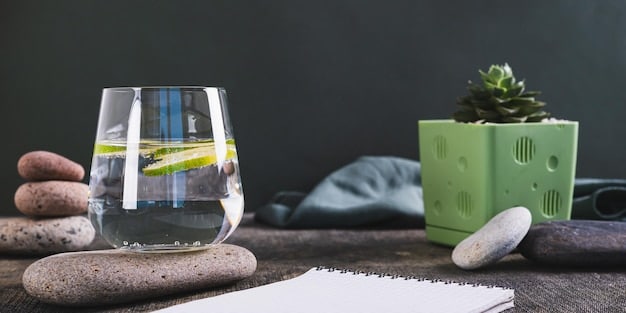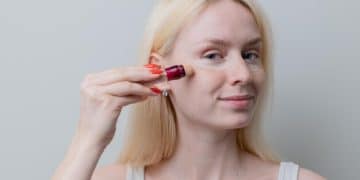The Truth About Skin Care: Unveiling Common Myths

Anúncios
Navigating the vast world of skin care can be perplexing, with endless products and advice, making it crucial to uncover the science-backed realities behind common claims and reveal what truly works for healthy, radiant skin.
In the vast and often confusing landscape of beauty and wellness, few areas generate as much discussion, debate, and sometimes, outright misinformation as the truth about skin care. From ancient remedies to cutting-edge scientific innovations, the quest for healthy, glowing skin has driven countless trends and spawned an industry worth billions. Yet, beneath the glossy advertisements and celebrity endorsements, what truly separates effective practices from mere marketing hype? This exploration delves into the core principles, common misconceptions, and evidence-based approaches that define authentic skin health, aiming to empower you with the knowledge to make informed decisions for your complexion.
Anúncios
Understanding Skin Physiology: More Than Just a Surface
Before dissecting specific products or routines, it’s essential to grasp the fundamental biology of your skin. Our skin, the body’s largest organ, acts as a vital protective barrier against environmental aggressors, regulates temperature, and plays a key role in our sensory experiences. Far from being a static surface, it’s a dynamic ecosystem constantly undergoing renewal and repair.
The Epidermal Barrier: Your First Line of Defense
The outermost layer, the epidermis, is crucial for preserving skin health. It’s composed primarily of keratinocytes, which form a protective brick-and-mortar structure, sealing in moisture and keeping out harmful substances. A compromised barrier can lead to dryness, irritation, and increased sensitivity.
- Ceramides: Essential lipids that hold skin cells together, reinforcing the barrier.
- Fatty Acids: Contribute to skin’s suppleness and integrity.
- Cholesterol: Another important lipid component supporting barrier function.
- Natural Moisturizing Factors (NMFs): Compounds like amino acids and lactic acid that attract and hold water within the skin.
Understanding this intricate structure helps in deciphering why certain ingredients like occlusives (e.g., petrolatum) or humectants (e.g., hyaluronic acid) work in different ways to support skin hydration and protection. It’s about working with your skin’s natural architecture, not against it.
Anúncios
The dermis, located beneath the epidermis, provides skin with its strength and elasticity, thanks to collagen and elastin fibers. This layer is also home to blood vessels, nerve endings, and hair follicles. As we age, the production of collagen and elastin naturally declines, contributing to visible signs of aging. Protecting these foundational components through antioxidants and sun protection is paramount for long-term skin health.
Decoding Ingredients: Separating Science from Speculation
The ingredient lists on skin care products can often resemble a complex chemical equation, intimidating even the most seasoned beauty enthusiast. However, focusing on a few key categories and understanding their proven benefits can simplify the process significantly. Beware of products that make grand claims based on exotic-sounding ingredients without solid scientific backing.
For instance, while certain botanical extracts may possess antioxidant properties, their efficacy often pales in comparison to well-researched compounds like vitamin C or niacinamide, whose benefits are extensively documented through clinical trials. It’s about efficacy and stability.

The Powerhouses You Need to Know
- Retinoids (Vitamin A derivatives): Gold standard for anti-aging, addressing fine lines, wrinkles, and acne by promoting cell turnover and collagen production.
- Vitamin C (Ascorbic Acid): A potent antioxidant that brightens skin, reduces hyperpigmentation, and stimulates collagen synthesis. It’s crucial for maintaining an even skin tone.
- Niacinamide (Vitamin B3): A multifaceted ingredient that calms inflammation, reduces redness, improves skin barrier function, and minimizes pore appearance.
- Hyaluronic Acid: A powerful humectant capable of holding up to 1,000 times its weight in water, providing intense hydration and plumping the skin.
Beyond these, look for ingredients like alpha hydroxy acids (AHAs) and beta hydroxy acids (BHAs) for chemical exfoliation, and various antioxidants like vitamin E and ferulic acid to combat free radical damage. Each ingredient has a specific role, and a well-formulated product often combines several for synergistic effects.
It’s equally important to consider what to avoid, particularly if you have sensitive skin. Common irritants include harsh fragrances, certain dyes, and some essential oils. Patch testing new products on a small area of skin before full application can help prevent adverse reactions. Remember, “natural” doesn’t always equate to “safe” for all skin types.
The Sunscreen Imperative: Your Daily Non-Negotiable
Few aspects of skin care are as universally agreed upon, yet often overlooked, as the daily use of sunscreen. This isn’t just about preventing sunburn; it’s the single most effective measure against premature aging and skin cancer. UV radiation, both UVA and UVB, is a relentless assailant, even on cloudy days or indoors near windows. Long-term sun exposure is the primary driver of wrinkles, dark spots, loss of elasticity, and the vast majority of skin cancers.
Understanding SPF and Broad-Spectrum Protection
SPF (Sun Protection Factor) primarily measures protection against UVB rays, which cause sunburn. For daily use, an SPF of 30 or higher is recommended. However, equally important is “broad-spectrum” protection, meaning the sunscreen shields against both UVB and UVA rays. UVA rays penetrate deeper into the skin and are largely responsible for photoaging.
- Mineral Sunscreens: Contain zinc oxide and/or titanium dioxide, physical blockers that sit on the skin’s surface to deflect UV rays. Generally considered gentle for sensitive skin.
- Chemical Sunscreens: Contain organic compounds that absorb UV radiation, converting it into heat that is then released from the skin. Varieties include avobenzone, oxybenzone, and octinoxate.
Applying sunscreen should be the final step in your morning skin care routine. The quantity matters: approximately a quarter teaspoon for the face and neck is a good guide. Reapplication every two hours, or more frequently if swimming or sweating, is vital for continuous protection. Make it a habit, regardless of the weather or your indoor/outdoor plans.
Integrating sunscreen seamlessly into your daily life can be achieved by choosing cosmetically elegant formulas that blend well under makeup or that offer additional skin care benefits, such as hydration or a subtle tint. The best sunscreen is truly the one you’ll use consistently.
Fact vs. Fiction: Debunking Common Skin Care Myths
The skin care world is rife with myths that can lead to ineffective practices or even harm. Separating these misconceptions from scientific realities is crucial for developing a truly beneficial routine. Many of these myths often stem from anecdotal evidence, outdated information, or pure marketing. By challenging these ingrained beliefs, we can approach skin care with a more informed and effective mindset.
Clearing Up the Confusion
- Myth: You can “close” or “open” your pores. Truth: Pores are fixed openings for hair follicles and sebaceous glands; they cannot open or close. While they can appear larger due to trapped oil and debris, they don’t change size with temperature.
- Myth: Oily skin doesn’t need moisturizer. Truth: All skin types, including oily, need hydration. Dehydrated oily skin can overcompensate by producing more oil. Choose lightweight, non-comedogenic moisturizers.
- Myth: Natural ingredients are always better. Truth: “Natural” doesn’t automatically mean safe or effective. Many natural ingredients can cause irritation (e.g., essential oils), while synthetic compounds are often highly stable and rigorously tested.
- Myth: You need a separate eye cream. Truth: While some eye creams have targeted ingredients for specific concerns like dark circles, a well-formulated facial moisturizer can often provide adequate hydration for the eye area, unless a specific concern warrants a specialized product.
Understanding the difference between perceived quick fixes and long-term results is key. Many overnight solutions promise revolutionary changes but seldom deliver. Patience and consistency are far more impactful than chasing the latest fad ingredient or device. The skin’s regenerative cycle means visible improvements often take weeks or even months.
Don’t fall for the idea that “no pain, no gain” applies to skin care. Your skin should not feel irritated or stung by daily products. While active ingredients like retinoids may cause initial dryness or purging, persistent irritation is a sign that a product may be too strong or unsuitable for your skin type, indicating it’s time to adjust your routine.
Building an Effective Skin Care Routine: Simplicity and Consistency
With an overwhelming array of products, constructing a daily skin care routine can feel daunting. However, an effective strategy often boils down to a few fundamental steps executed consistently. The goal is to support your skin’s natural functions, address specific concerns, and protect it from environmental damage. More expensive or complex isn’t always better; smart choices tailored to your skin’s needs are.
The Core Pillars of a Daily Routine
- Cleanse: Gentle cleansing removes dirt, oil, and makeup without stripping the skin’s natural moisture barrier. Over-cleansing or using harsh cleansers can lead to irritation and dryness.
- Treat (Actives): This step involves applying targeted treatments like serums or essences that contain active ingredients such as retinoids, vitamin C, or niacinamide to address specific concerns like signs of aging, acne, or hyperpigmentation.
- Moisturize: Replenishes hydration, supports the skin barrier, and locks in the benefits of previously applied treatments. Even oily skin needs moisturizer.
- Protect (SPF): The non-negotiable final step in the morning to shield skin from harmful UV radiation. This is crucial for preventing premature aging and skin cancer.
Listen to your skin. What works for one person may not work for another due to individual skin type, concerns, and sensitivities. Introducing new products one at a time allows you to observe how your skin reacts and identify potential irritants. Patch testing is always recommended for new products, especially those with active ingredients.
Morning routines typically focus on protection (antioxidant serum, moisturizer, SPF), while evening routines emphasize repair and renewal (cleansing, active treatments like retinoids, and a richer moisturizer). Building a routine is an ongoing process of observation and adjustment rather than a fixed formula.
Lifestyle and Skin Health: Beyond the Bottle
While topical products play a significant role, the overall health of your skin is inextricably linked to your lifestyle choices. What you consume, how you manage stress, and the quality of your sleep all contribute to your skin’s appearance and resilience. Skin care isn’t just about what you put on your face; it’s a holistic endeavor reflecting your internal well-being.
Hydration levels, for instance, are deeply affected by water intake. While topical moisturizers are vital, ensuring you drink enough water throughout the day contributes to overall skin plumpness and elasticity. Similarly, a diet rich in antioxidants, healthy fats, and lean proteins provides the building blocks and protective compounds your skin needs to thrive from within.

Key Lifestyle Factors for Glowing Skin
- Nutrition: A balanced diet with emphasis on fruits, vegetables, whole grains, and healthy fats (e.g., avocados, nuts, fatty fish) provides antioxidants, vitamins, and minerals essential for skin repair and protection.
- Hydration: Adequate water intake supports skin elasticity and prevents dehydration, which can make fine lines more pronounced.
- Stress Management: Chronic stress can trigger breakouts, inflammation, and exacerbate conditions like eczema. Practices like meditation, yoga, or regular exercise can mitigate these effects.
- Sleep Quality: During sleep, your skin undergoes significant repair and regeneration. Poor sleep can lead to dullness, under-eye circles, and impaired barrier function. Aim for 7-9 hours of quality sleep.
Exercise also plays a vital role by improving blood circulation, which helps deliver oxygen and nutrients to skin cells and carries away waste products. Just remember to cleanse your face promptly after workouts to prevent breakouts from sweat and dirt accumulation.
Environmental factors beyond the sun also impact skin. Pollution exposure can lead to free radical damage and premature aging. Antioxidant-rich topical products and thorough cleansing can help counteract these effects. A truly comprehensive approach integrates both external topical care with internal wellness practices.
Innovations and the Future of Skin Care
The field of skin care is constantly evolving, driven by scientific discovery and technological advancements. What was once considered experimental is now becoming mainstream, offering new avenues for addressing complex skin concerns. Understanding these emerging trends can provide insight into the potential future of skin health, but also requires a critical eye to discern true progress from fleeting fads. The focus is increasingly on precision and personalization.
Emerging Trends and Technologies
- Microbiome-Friendly Products: Growing research highlights the importance of the skin’s microbiome—the community of microorganisms living on its surface. Products supporting a healthy bacterial balance are emerging to improve barrier function and reduce inflammation.
- Personalized Skin Care: Advancements in AI and genetic testing allow for highly customized product recommendations based on individual skin needs, lifestyle, and even DNA. This moves away from a “one-size-fits-all” approach.
- Bio-hacking and Longevity: Ingredients and technologies that focus on cellular repair, autophagy, and extending cellular lifespan are gaining traction, aiming to combat the root causes of aging at a molecular level.
- Wearable Tech and Smart Devices: Devices that monitor skin hydration, UV exposure, or even deliver active ingredients through microcurrents or LED therapy are becoming more sophisticated and accessible for at-home use.
While exciting, these innovations often come with a higher price point and require more research before their long-term efficacy and safety are fully understood. It’s crucial for consumers to remain discerning, looking for peer-reviewed studies and credible dermatological endorsements rather than relying solely on influencer marketing or anecdotal claims. The promise of science is real, but its responsible application is paramount.
The future of skin care appears to be increasingly holistic and data-driven, integrating advanced diagnostics with personalized solutions. This shift means a deeper understanding of individual biochemistry and environmental impacts, moving towards truly tailored skin health strategies. However, the foundational principles of cleansing, protecting, and targeting with proven actives will likely remain the bedrock of any effective routine for decades to come.
| Key Point | Brief Description |
|---|---|
| 🔬 Science Matters | Base skin care decisions on proven ingredients and skin physiology, avoiding anecdotal claims. |
| ☀️ Sunscreen is Key | Daily broad-spectrum SPF 30+ is the most crucial step for anti-aging and cancer prevention. |
| 🤔 Debunk Myths | Separate fact from fiction; pores don’t open/close, and all skin types need moisturization. |
| 🧘♀️ Holistic Approach | Lifestyle factors like diet, hydration, stress, and sleep significantly impact skin health. |
Frequently Asked Questions About Skin Care Truths
While multi-step routines can be beneficial, a simple, consistent routine is often more effective than an elaborate one. Focus on cleansing, moisturizing, and daily sun protection as your core steps. Adding one or two targeted treatments for specific concerns is usually sufficient for most people. Complexity doesn’t always equal efficacy.
Yes, diet plays a significant role in skin health. A diet rich in antioxidants, healthy fats, and proper hydration can support skin barrier function and reduce inflammation. Conversely, high sugar intake or highly processed foods may exacerbate certain skin conditions. It’s about overall nutritional balance for systemic health.
Not necessarily. While some high-end products utilize advanced formulations or unique ingredients, many effective and well-formulated products are available at more accessible price points. The cost of a product doesn’t always correlate with its efficacy. Focus on evidence-backed ingredients relevant to your skin concerns.
Understanding your skin type (e.g., oily, dry, combination, sensitive) is crucial for selecting appropriate products. Products formulated for oily skin might be too drying for dry skin, and vice versa. Using products unsuitable for your type can lead to irritation or ineffective results. Tailoring your routine ensures optimal benefits.
Consistently using products that work for your skin is generally more beneficial than frequently switching. While it’s fine to adapt your routine seasonally or as your skin concerns change, constantly introducing new products can make it difficult to determine what’s effective and potentially lead to irritation or sensitization. Give products time to work.
Conclusion: Empowering Your Skin Care Journey
The journey towards healthy, radiant skin is less about chasing fleeting trends and more about embracing informed choices rooted in scientific understanding and consistent, mindful practices. By dissecting the common myths, appreciating the nuances of skin physiology, and prioritizing a balanced, evidence-based approach, you empower yourself to navigate the vast skin care landscape with confidence. Remember, the true secret to optimal skin health lies not in a single miracle product, but in a holistic strategy that combines effective topical care with a healthy lifestyle, patience, and a willingness to learn and adapt as your skin evolves.





